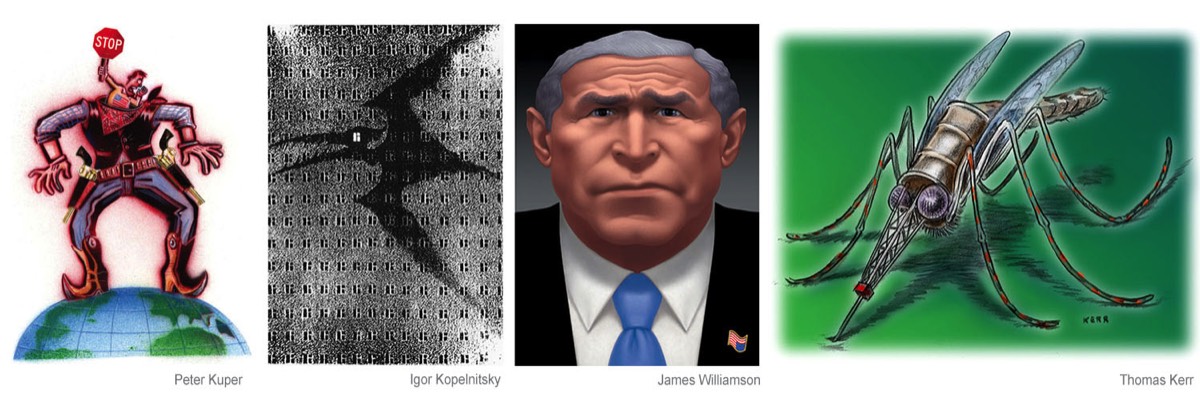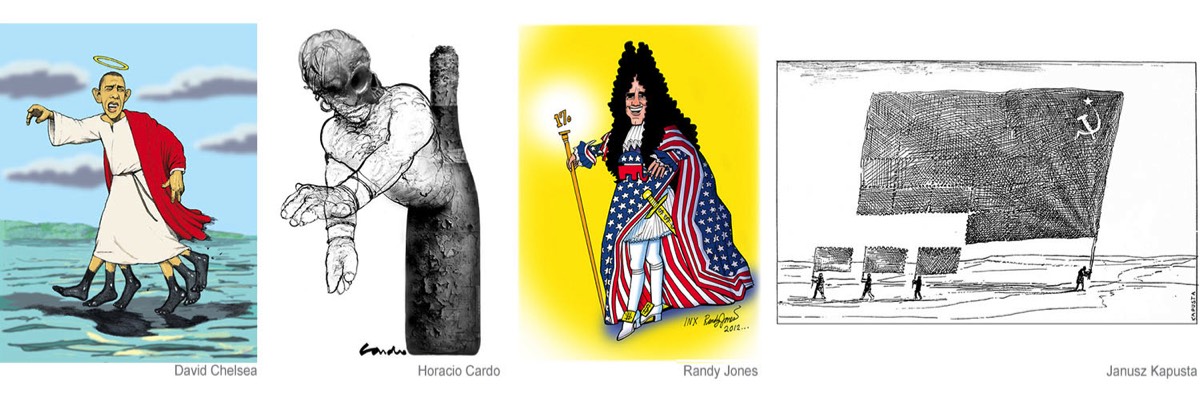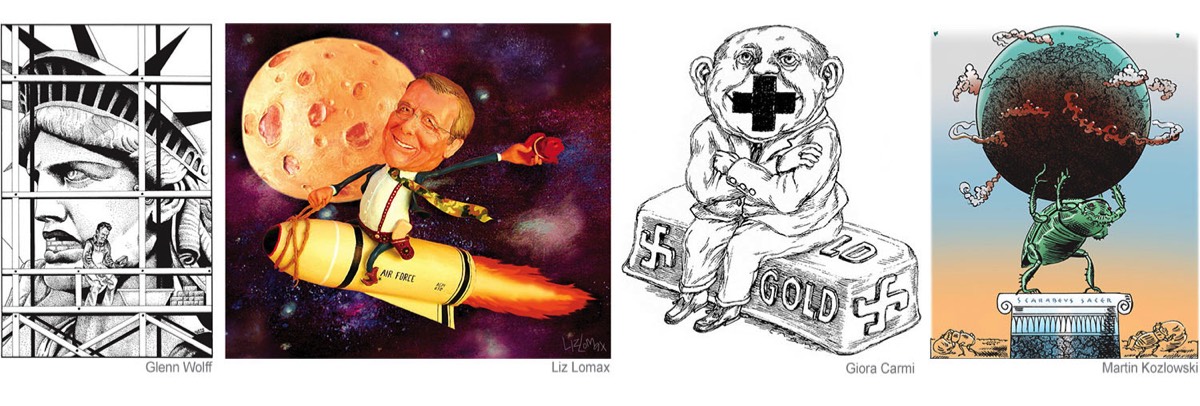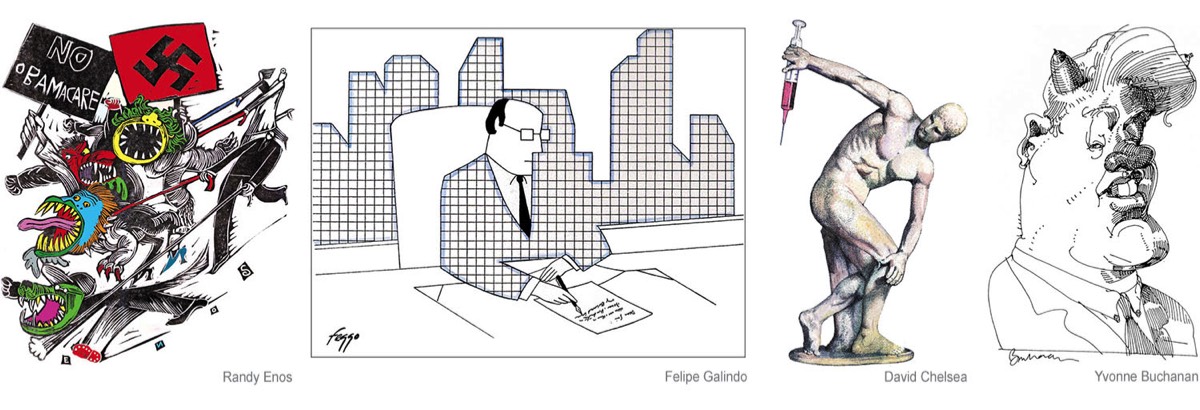About INX
In 1980, at the dawn of the Age of Reagan, a corps of editorial illustrators who did work for the New York Times banded together to form the group INX.
The founding members were Jean-François Allaux, Bob Gale, Vivienne Flesher, Steven Guarnaccia, Walter Gurbo, Frances Jetter, Randy Jones, Carlos Llerena Aguirre, John MacLeod, Robert Neubecker, Charles Waller, and Oliver Williams. The name INX was a play on “inks,” the essential medium employed by these pen and brush artists.
They shared a desire to produce and distribute uncensored political images to the news marketplace, keeping editorial control in the hands of the creators. Freelancers granted such freedom were galvanized, producing art that was both personal and powerful while also being affordable to publications in all markets.
Camaraderie and passion for the work sustained the group for over three years until the demands of managing a small business communally caused a rift and drove members away. Those who remained stabilized INX by negotiating a long-term contract with United Feature Syndicate. Under this new arrangement, the contributors were encouraged to concentrate on their art instead of its promotion and distribution.
At the beginning of each week, four or more artists were commissioned by one of the member art directors Randy Jones, John MacLeod, or Robert Neubecker to contribute illustrations on the topics of the day. For several years that entailed a meeting on Monday at the midtown offices of United Feature, where the artists met and bounced ideas and sketches off one another. Later, the initial communications were made by phone and fax as Peter Kuper and Martin Kozlowski assumed the roles of co-art directors.
By midweek the finished artwork was dropped off. It was then photostatted, printed onto glossy paper, stapled into 8.5”x11” packages, and syndicated to a wide range of savvy newspapers in the U.S. and abroad.
On a good day, the group continued on to a brunch of brainstorming and gossip, a welcome diversion for toilers in an essentially solitary profession. In this loose-limbed fashion, INX generated a body of work that is now composed of over 9,000 images spanning seven presidencies and more than forty years.
By early 2002, consolidation in the syndication market had begun and the INX group was unable to negotiate a new contract with United Feature. Facing possible extinction, several of the members banded together to establish a website, inxart.com, and self-syndicate work in a digital variation on the group’s original model. Reflecting advancements in the print technology for newspapers and the explosion of news websites, the online version of INX began featuring full-color art.
In 2020, the site was redesigned to better serve this fast-changing and diverse media landscape.
The founding members were Jean-François Allaux, Bob Gale, Vivienne Flesher, Steven Guarnaccia, Walter Gurbo, Frances Jetter, Randy Jones, Carlos Llerena Aguirre, John MacLeod, Robert Neubecker, Charles Waller, and Oliver Williams. The name INX was a play on “inks,” the essential medium employed by these pen and brush artists.
They shared a desire to produce and distribute uncensored political images to the news marketplace, keeping editorial control in the hands of the creators. Freelancers granted such freedom were galvanized, producing art that was both personal and powerful while also being affordable to publications in all markets.
Camaraderie and passion for the work sustained the group for over three years until the demands of managing a small business communally caused a rift and drove members away. Those who remained stabilized INX by negotiating a long-term contract with United Feature Syndicate. Under this new arrangement, the contributors were encouraged to concentrate on their art instead of its promotion and distribution.
At the beginning of each week, four or more artists were commissioned by one of the member art directors Randy Jones, John MacLeod, or Robert Neubecker to contribute illustrations on the topics of the day. For several years that entailed a meeting on Monday at the midtown offices of United Feature, where the artists met and bounced ideas and sketches off one another. Later, the initial communications were made by phone and fax as Peter Kuper and Martin Kozlowski assumed the roles of co-art directors.
By midweek the finished artwork was dropped off. It was then photostatted, printed onto glossy paper, stapled into 8.5”x11” packages, and syndicated to a wide range of savvy newspapers in the U.S. and abroad.
On a good day, the group continued on to a brunch of brainstorming and gossip, a welcome diversion for toilers in an essentially solitary profession. In this loose-limbed fashion, INX generated a body of work that is now composed of over 9,000 images spanning seven presidencies and more than forty years.
By early 2002, consolidation in the syndication market had begun and the INX group was unable to negotiate a new contract with United Feature. Facing possible extinction, several of the members banded together to establish a website, inxart.com, and self-syndicate work in a digital variation on the group’s original model. Reflecting advancements in the print technology for newspapers and the explosion of news websites, the online version of INX began featuring full-color art.
In 2020, the site was redesigned to better serve this fast-changing and diverse media landscape.







